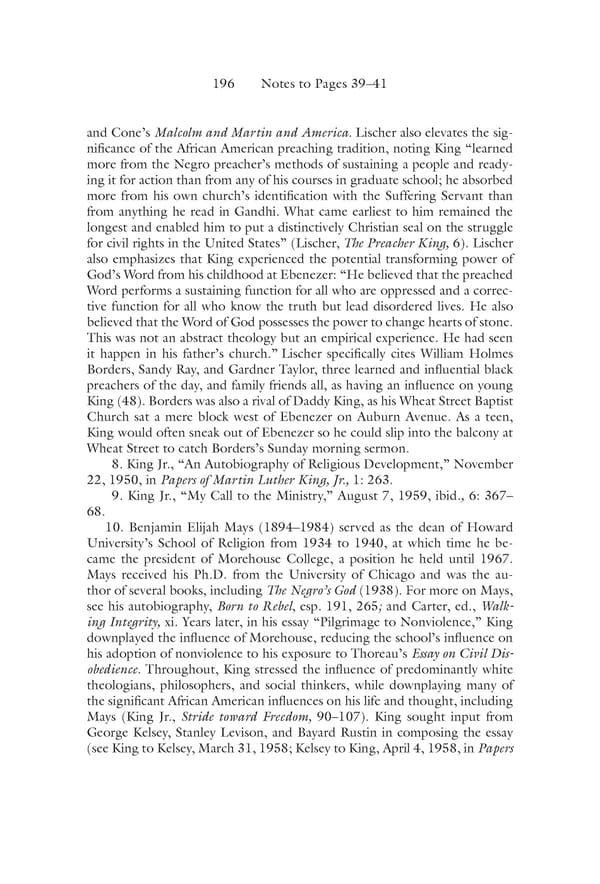196 Notes to Pages 39–41 and Cone’s Malcolm and Martin and America. Lischer also elevates the sig- nificance of the African American preaching tradition, noting King “learned more from the Negro preacher’s methods of sustaining a people and ready- ing it for action than from any of his courses in graduate school; he absorbed more from his own church’s identification with the Suffering Servant than from anything he read in Gandhi. What came earliest to him remained the longest and enabled him to put a distinctively Christian seal on the struggle for civil rights in the United States” (Lischer, The Preacher King, 6). Lischer also emphasizes that King experienced the potential transforming power of God’s Word from his childhood at Ebenezer: “He believed that the preached Word performs a sustaining function for all who are oppressed and a correc- tive function for all who know the truth but lead disordered lives. He also believed that the Word of God possesses the power to change hearts of stone. This was not an abstract theology but an empirical experience. He had seen it happen in his father’s church.” Lischer specifically cites William Holmes Borders, Sandy Ray, and Gardner Taylor, three learned and influential black preachers of the day, and family friends all, as having an influence on young King (48). Borders was also a rival of Daddy King, as his Wheat Street Baptist Church sat a mere block west of Ebenezer on Auburn Avenue. As a teen, King would often sneak out of Ebenezer so he could slip into the balcony at Wheat Street to catch Borders’s Sunday morning sermon. 8. King Jr., “An Autobiography of Religious Development,” November 22, 1950, in Papers of Martin Luther King, Jr., 1: 263. 9. King Jr., “My Call to the Ministry,” August 7, 1959, ibid., 6: 367– 68. 10. Benjamin Elijah Mays (1894–1984) served as the dean of Howard University’s School of Religion from 1934 to 1940, at which time he be- came the president of Morehouse College, a position he held until 1967. Mays received his Ph.D. from the University of Chicago and was the au- thor of several books, including The Negro’s God (1938). For more on Mays, see his autobiography, Born to Rebel, esp. 191, 265; and Carter, ed., Walk- ing Integrity, xi. Years later, in his essay “Pilgrimage to Nonviolence,” King downplayed the influence of Morehouse, reducing the school’s influence on his adoption of nonviolence to his exposure to Thoreau’s Essay on Civil Dis- obedience. Throughout, King stressed the influence of predominantly white theologians, philosophers, and social thinkers, while downplaying many of the significant African American influences on his life and thought, including Mays (King Jr., Stride toward Freedom, 90–107). King sought input from George Kelsey, Stanley Levison, and Bayard Rustin in composing the essay (see King to Kelsey, March 31, 1958; Kelsey to King, April 4, 1958, in Papers
 Becoming King: Martin Luther King Jr. Page 216 Page 218
Becoming King: Martin Luther King Jr. Page 216 Page 218